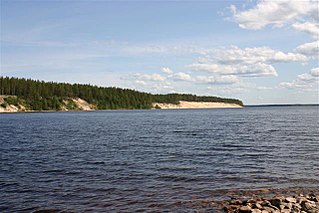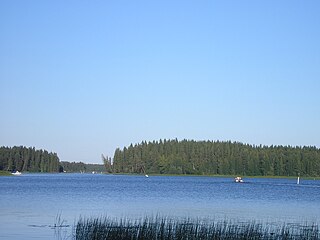
The geography of Finland is characterized by its northern position, its ubiquitous landscapes of intermingled boreal forests and lakes, and its low population density. Finland can be divided into three areas: archipelagoes and coastal lowlands, a slightly higher central lake plateau and uplands to north and northeast. Bordering the Baltic Sea, Gulf of Bothnia, and Gulf of Finland, as well as Sweden, Norway, and Russia, Finland is the northernmost country in the European Union. Most of the population and agricultural resources are concentrated in the south. Northern and eastern Finland are sparsely populated containing vast wilderness areas. Taiga forest is the dominant vegetation type.

Lake Ladoga is a freshwater lake located in the Republic of Karelia and Leningrad Oblast in northwestern Russia, in the vicinity of Saint Petersburg.

The Karelian Isthmus is the approximately 45–110-kilometre-wide (30–70 mi) stretch of land, situated between the Gulf of Finland and Lake Ladoga in northwestern Russia, to the north of the River Neva. Its northwestern boundary is a line from the Bay of Vyborg to the westernmost point of Lake Ladoga, Pekonlahti. If the Karelian Isthmus is defined as the entire territory of present-day Saint Petersburg and Leningrad Oblast to the north of the Neva and also a tiny part of the Republic of Karelia, the area of the isthmus is about 15,000 km2 (5,800 sq mi).

Näsijärvi is a lake 95 metres (312 ft) above sea level, in the Pirkanmaa region of southern Finland. Näsijärvi is the biggest lake in the Tampere area at 256 square kilometres (99 sq mi) in size. The city of Tampere was built along the Tammerkoski rapids, through which the lake drains into Pyhäjärvi. The water quality of the lake has improved as forest industry has decreased the amount of waste water.

The Vuoksi is a river running through the northernmost part of the Karelian Isthmus from Lake Saimaa in southeastern Finland to Lake Ladoga in northwestern Russia. The river enters Lake Ladoga in three branches, an older main northern branch at Priozersk (Käkisalmi), a smaller branch a few kilometers to the north of it, and a new southern branch entering 50 kilometers (31 mi) further southeast as Burnaya River, which has become the main stream in terms of water discharge. Since 1857, the old northern distributaries drain only the lower reaches of the Vuoksi basin and are not fed by Lake Saimaa. The northern and southern branches actually belong to two separate river systems, which at times get isolated from each other in dry seasons.

Oulujärvi or Lake Oulu or Ule, is a large lake in the Kainuu region of Finland. It is also historically known as Lake Cajania from a former name of Kainuu. With an area of 928 square kilometres (358 sq mi) it is the fifth largest lake in the country. The lake is drained by the Oulu River, which flows northwestward from the lake into the Gulf of Bothnia. Its nickname is the "Kainuu Sea", and it is bordered by the three municipalities of Vaala, Paltamo, and Kajaani. About 40 percent of the lake is in Vaala.

The Kokemäenjoki is a river in southwestern Finland.

Pielinen is the fourth largest lake of Finland, with a drainage basin area of 12,823 km2 (4,951 sq mi) equally distributed between eastern Finland and Russia. The creation of the lake and its outlet is attributed to a post-glacial isostatic rebound, which resulted in uplift of the land. As is common in Finnish lakes, the lake's color is dark, due to the high proportion of bogs present in the catchment of the drainage basin that drains humic substances.

Ähtärinjärvi is a lake in Finland. It is situated in the municipalities of Ähtäri, Alajärvi and Soini in the Southern Ostrobothnia region in western Finland. The lake is part of the Kokemäenjoki basin and drains through a chain of lakes that includes among others the lakes Toisvesi and Tarjanne in the Pirkanmaa region, where the lake Tarjanne in its turn drains into the Lake Ruovesi.

Isojärvi is a medium-sized lake in Finland. It is situated in the region of Satakunta in Western Finland and in the municipalities of Pomarkku in south and Siikainen in north. The lake is a part of the Karvianjoki basin that drains into the Gulf of Bothnia.

Vanajavesi is a large lake in southern Finland, in the provinces of Pirkanmaa and Kanta-Häme. It is part of the Kokemäenjoki basin. The lake gathers waters from a wide area in the regions of Pirkanmaa, Tavastia Proper and parts of the Päijänne Tavastia region.

Kulovesi is a medium-sized lake in Finland. It is situated in the area of the towns Nokia and Sastamala in the Pirkanmaa region. The lake is part of the Kokemäenjoki basin. The lake Pyhäjärvi drains through the Nokianvirta River into the Lake Kulovesi from the west and the lake Kyrösjärvi through a chain of lakes and the Siuronkoski rapids from the north near the Siuro village. The lake gathers waters from an area of 20 822 km2 that includes the whole upper part of the Kokemäenjoki basin. Lake Kulovesi drains into the lake Rautavesi which in its turn drains into the lake Liekovesi and this finally into the Kokemäenjoki River.

Loppijärvi is a medium-sized lake in Finland. It is situated in the municipality of Loppi in the Tavastia Proper region. The lake is part of Kokemäki River basin and it drains through Tervajoki River into Lake Kernaalanjärvi which in its turn drains into Lake Vanajavesi through Hiidenjoki River. On the north shore of the lake is Kirkonkylä, the administrative center of the Loppi, and on the south shore the village of Läyliäinen.
Lummene is a lake in Finland in the municipality of Kuhmoinen in the Central Finland region.

Lake Ruovesi is a medium-sized lake in Finland. It is situated in the municipalities of Ruovesi and Mänttä-Vilppula in the Pirkanmaa region in western Finland. The lake is a part of the Kokemäki River basin and its main inflows are the Lake Tarjanne in north and the Lake Kuorevesi in the east. The lake drains into the lake Palovesi in south, which in its turn drains into the lake Näsijärvi.

A bifurcation lake is a lake that has outflows into two different drainage basins and thus the drainage divide cannot be defined exactly because it is situated in the middle of the lake.

St. Olaf's Church in Tyrvää is a late medieval fieldstone church in Tyrvää, Sastamala, Finland. It is located on the shore of lake Rautavesi. The church was built approximately in 1510–1516 and burnt down by a burglar on 21 September 1997.

Karkku is a locality and former municipality in Pirkanmaa region, Finland. It was consolidated in 1973 with Vammala, which in turn, was consolidated with Äetsä and Mouhijärvi into a town of Sastamala in 2009. Karkku is located by the lake Rautavesi, about 13 kilometres north of the Sastamala town center.


















